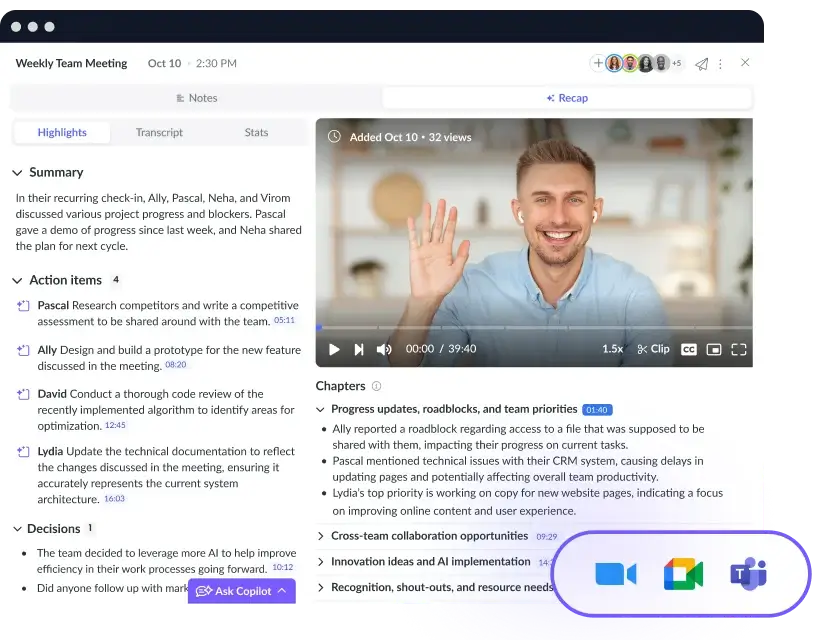Meeting Agenda Outline – Best Practice and Most Effective Meeting Structure to Follow
Turn your chaotic, unproductive meetings into delightful, productive meetings by using a meeting agenda for all of your meetings!
A meeting without a meeting agenda is like a play without a script – chaos indeed!
Rather than trying to host or sit through a chaotic meeting, use a meeting agenda to make the chaos disappear. Not only do meeting agendas make meetings more productive, efficient, and delightful, but they also ensure that something comes from your meetings.
Antony Jay, Harvard Business Review contributor, compares having a meeting agenda to going to the doctor’s office,
“The reason for an item being on a meeting agenda is usually like the symptom we go to the doctor with: “I keep getting this pain in my back” is analogous to “Sales have risen in Germany but fallen in France.” In both cases, it is clear that something is wrong and that something ought to be done to put it right. But until the visit to the doctor, or the meeting of the European marketing committee, that is about all we really know.”
- What is a meeting agenda outline?
- How you outline a meeting agenda
- What should be included in the meeting agenda?
- Meeting agenda outline examples
What is a meeting agenda outline?
Imagine blindly walking into a meeting with no idea what the meeting will be about, how long it will take (but expecting it will be a while, per usual), and who else will be there; You’d be left with no expectations going into the meeting and no way of planning your day around the meeting. And you may ask “why would you want expectations going into a meeting?”.
The truth is that formulating expectations of what the meeting will be about will help you prepare questions and topics that you want to discuss. So, having a meeting agenda outline is ESSENTIAL! On top of providing expectations to help you plan and have perspective, meeting agenda outlines also provide purpose and order to the meeting…

No agenda, no attenda!
Every meeting should have an agenda so you can show up prepared and ready to use everyone’s time effectively. Use a collaborative meeting software like Fellow.
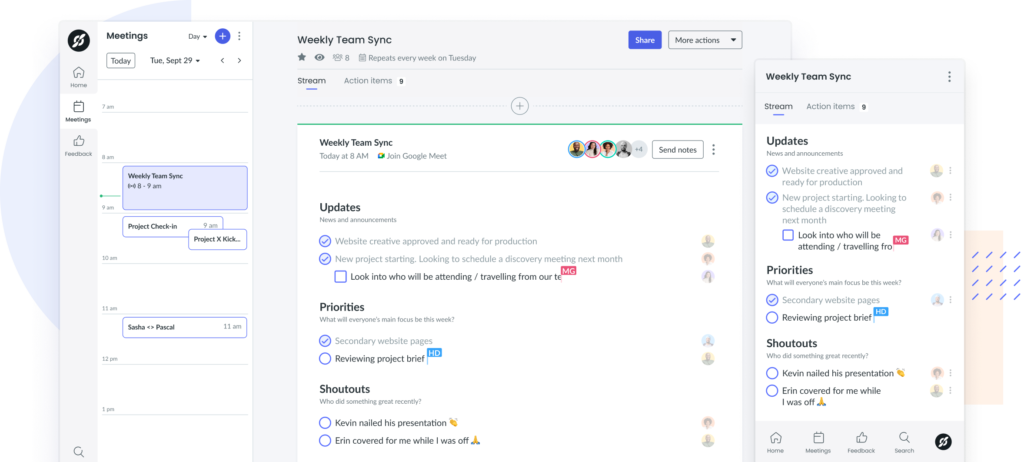
Purpose
If the meeting has no purpose, it’s a waste of everyone’s time. Now, I know you might be thinking that of course, every meeting has a purpose – it wouldn’t be scheduled if it didn’t! But sometimes meetings are scheduled for the sake of having a meeting, not because there is something to discuss.
This happens most frequently with recurring meetings seeing that they are scheduled to recur weekly or biweekly for example. Rather than deciding if the meeting has a purpose, thus needs to happen, the meeting just happens.
According to a Harvard Business Review study, 71% of senior managers surveyed said that meetings were unproductive and inefficient. Why? Because there was no purpose. So, it is very important to ensure that all your meetings have a meeting agenda outline to help you determine if there is a purpose.
Additionally, Roger Schwarz, Harvard Business Review contributor, says,
“Note whether the purpose of the topic is to share information, seek input for a decision, or make a decision. It’s difficult for team members to participate effectively if they don’t know whether to simply listen, give their input, or be part of the decision-making process.”
Order
Nothing is worse than joining a chaotic meeting. These meetings consist of random topics being thrown in causing everyone to go off-topic, are typically very long, and almost always result in no decisions made, no action items assigned, and no more clarity than before the meeting (sometimes even less!).
These types of meetings happen because there is a lack of order. And, these types of meetings happen more often than you’d think; According to a Forbes study, 50% of people feel that meetings are not a good use of their time. So, having a meeting agenda outline will ensure that there is order in each meeting by clearly outlining how much time is allotted to each thing on your agenda.
What determines how you outline a meeting agenda?
When you are trying to decide which meeting agenda outline you want to use, it is useful to look through a variety of meeting agenda templates. Choosing the right meeting agenda template for your team will depend on a few things – here are a few things to ask yourself:
Is it a recurring meeting?
If so, pick a meeting template with recurring topics that will serve your team every week to make the meeting helpful and engaging. For example, choose a template that celebrates wins at the beginning of each meeting to give your team members a space to be appreciated and show off their hard work.
What type of meeting is it? (For example a 1-on-1 vs. team meeting)
Picking a meeting agenda template based on the type of meeting you are having will ensure that your meeting is productive. For example, for a 1-on-1 meeting, you may choose a template that has a section for personal feedback on your latest work. However, you wouldn’t use this template for a team meeting because the purpose of a team meeting is not to evaluate each person’s work in-depth.
Who is your audience?
Picking a meeting agenda template based on your audience will ensure that your meeting is engaging for all participants. For example, if you are having a meeting with somebody you don’t know, it may be worth your time to choose a template that begins your meeting with some icebreakers to get to know each other. However, if you are having a meeting with a colleague you’ve known for a long time, you wouldn’t choose that same template because you likely already know those things about them.
How many meeting attendees will be there?
The last thing to consider when you are choosing a meeting agenda template is to look at how many people will be in the meeting. For example, if you have a small group of participants, you can choose a template that allows each person to discuss their priorities for the week. But, if you have a large group of participants, this would be inefficient because it would take too long.
Choosing the right meeting agenda template is important to ensure that your meetings are productive and efficient. Asking team members for feedback on the templates will also help you determine if the template you are using is working for everyone. Don’t be afraid to change up the template from time to time as more people join your team or as your team’s priorities shift as well!
What should be included in the meeting agenda?
Now that you understand the HUGE importance of a meeting agenda, let’s show you what to include in it…
1 Talking points
For each topic that will be discussed during the meeting, big or small, you must include a talking point on the agenda for it. This ensures that there is enough time to discuss each topic and that everyone’s points are heard.
For example, if you want to discuss the organic traffic on your company’s social media sites, adding “Organic traffic update” to the agenda will show other meeting participants that you will be bringing this up. This also allows other team members to plan questions or comments relating to this topic before the meeting.
Furthermore, use the parking lot method for talking points that are not on the meeting agenda but that are brought up during the meeting. This ensures that those topics are put in the “parking lot” for another time so that your meeting doesn’t go off-topic and overtime.
Pro tip: If you’re using a meeting management tool like Fellow, not only can you check off the talking points as you discuss them, as well as make notes about questions and comments from the team, you can also see how much time is left in the meeting in the calendar view.
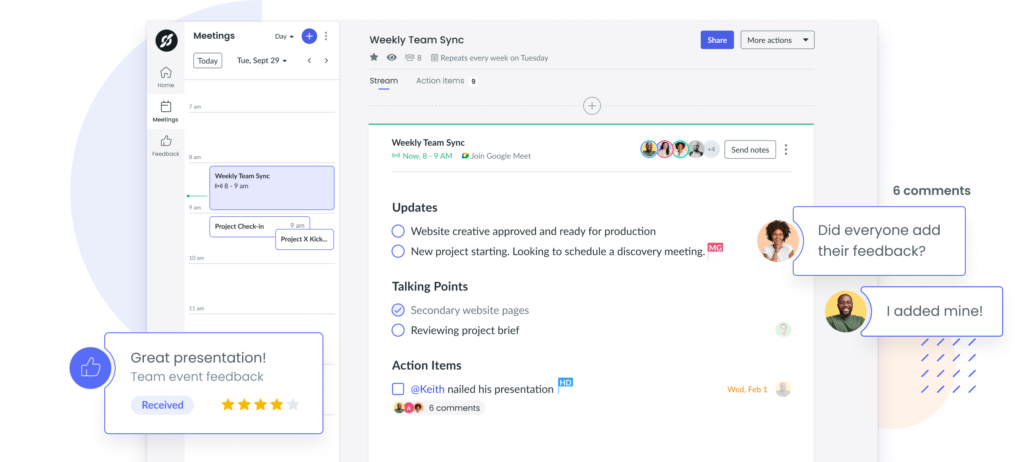
2 Comments and questions
It is almost certain that there will always be comments and questions during a meeting. Therefore, it is important to include a section for comments and questions so that you are not stuck at the end of the meeting trying to answer everyone’s questions quickly to end the meeting on time.
Additionally, if this space is not created, oftentimes team members will hold back their questions because they will feel like they are wasting time or unsure when to bring their questions up. So, including a section for comments and questions will provide a welcoming space for team members to contribute.
3 Action items
If your meeting results in no action items, was it really a productive meeting? The answer is no, it was not.
Productive meetings are meetings that result in meaningful outcomes. This means that everyone has a clear idea of what their next steps should be. Whether it’s a concrete task like working on assignment X or something more abstract like creating more content as a team, there should always be a next step.
4 Meeting minutes
Meeting minutes are a written record of everything discussed during the meeting. This includes the talking points, comments and questions, and action items. Meeting minutes are important because they provide something to look back on if you forget something that was discussed and serve as an outline of the meeting for people who couldn’t attend. Furthermore, seeing meeting minutes record action items assigned, they ensure that everyone is held accountable for their tasks.
Meeting agenda outline examples
Apart from the above essential things that need to be included in your meeting agenda, there are a host of other topics that you can include in your agenda to keep your meetings more engaging and effective:
Goals and priorities
Including a section in your meeting agenda for goals and priorities will help prompt teamwork. If you see that your co-worker has a lot of priorities this week and you don’t, you can offer to help them with some of their tasks.
Additionally, seeing your team members’ goals and priorities is helpful because sometimes your goals and priorities will overlap. Thus, you can all work as a team to achieve these overlapping goals.
Finally, recording your goals and priorities for the week will promote accountability. If your team member says that they will do X, Y and Z this week, your manager will know who to go to if the task is incomplete.
“Goal-setting theory demonstrates that goals energize, focus attention, and promote persistence, all of which lead to better performance.” – Steven G. Rogelberg, Harvard Business Review Contributor.
Questions to address
Adding a “questions to address” section to your agenda will provide team members with a space to ask questions that may not have to do with the purpose of the meeting, while still allotting time for this. For example, if you are struggling with one of your tasks, you can ask team members for their input on what to do in this section. And although it may not have to do with the purpose of the meeting, as long as the question is put on the agenda, thus time is saved for it, it is a great opportunity to ask for help with everyone gathered.
Puzzles and challenges to brainstorm
Whether it’s a team challenge or a personal challenge, allotting time in your meeting agenda for puzzles and challenges to brainstorm is important. This will foster collaboration and help out team members who are struggling with something.
A great example of this is what we do at Fellow during our weekly Marketing Team Meetings. Each month we hold #ManagerChats on Twitter where we do a live Q&A with some of the world’s best managers. And, to help formulate the topic and questions of each month’s chat, once a month our marketing coordinator asks our team to brainstorm ideas during this allotted time in the meeting agenda. So, although the weekly meetings are to update the team on what everyone’s working on and set action items for the week, they also provide a space for team members to reach out for help.
Purpose of each task
As humans, everything we do has a purpose. We cut our lawn for the purpose of having nice short grass and we watch tv for the purpose of entertaining ourselves. So, it is only natural to want to do tasks that serve a purpose, specifically help our company in some shape or form. If we feel like what we are doing has no purpose, we won’t feel like our work has any value or importance.
Thus, it is important to clarify the purpose of each task. For example, if you ask a co-worker to write an article on meeting agendas (like I’m doing here!), you will explain to them that the purpose of this is to create content for users to read and educate users on the topic.
Meeting overview
It is unrealistic to expect everyone to attend every meeting; somebody is usually sick, on vacation, or taking a personal day. So, it is important to make a meeting overview for those who missed the meeting so that they can still be informed on what was discussed and decided. Meeting overviews also ensure that everyone has a clear idea of what went down during the meeting and help answer any uncertainties. Try these meeting templates for your next meetings!

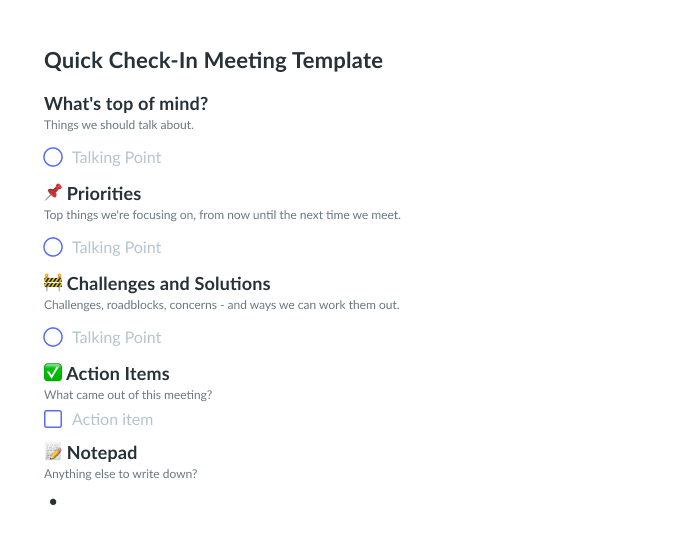
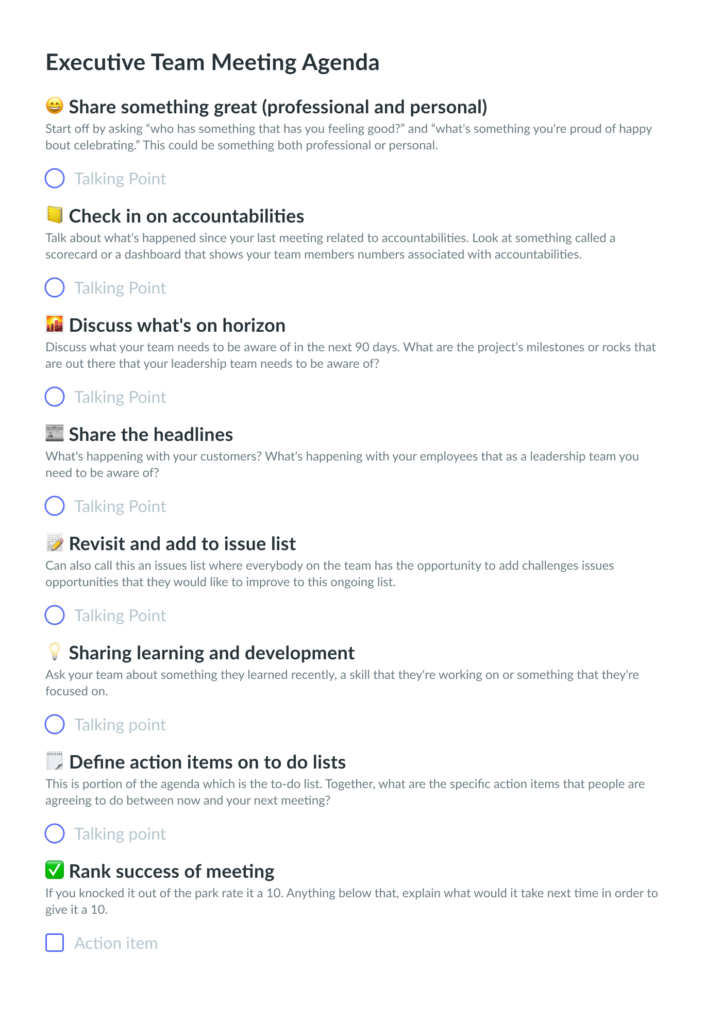
Parting advice
Meetings without meeting agendas lack purpose and order and are unproductive and inefficient. Additionally, they result in resentment towards meetings and a lack of engagement.
However, meetings shouldn’t be that way!
So, implementing the above things in your meeting agenda will forever change your meetings. Rather than your meetings being associated with terms like “unproductive”, “inefficient”, and “resentment”, they will be associated with words like “productive”, “efficient”, and “delightful”!
